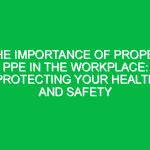Introduction
Creating a safe work environment is crucial for the well-being of employees and the success of any organization. By implementing proper safety measures, companies can prevent accidents, reduce injuries, and promote a culture of health and safety. In this article, we will discuss 10 essential tips for creating a safe work environment that prioritizes the health and well-being of all employees.
1. Conduct Regular Safety Training
One of the most important steps in creating a safe work environment is to provide regular safety training for all employees. This training should cover topics such as proper lifting techniques, emergency procedures, and the proper use of safety equipment. By ensuring that all employees are well-trained in safety protocols, companies can reduce the risk of accidents and injuries in the workplace.
Key Points:
– Schedule regular safety training sessions for all employees.
– Cover topics such as emergency procedures, hazard recognition, and safety equipment usage.
– Provide refresher courses to ensure that employees stay up-to-date on safety protocols.
2. Implement Safety Policies and Procedures
Another essential tip for creating a safe work environment is to establish clear safety policies and procedures. These policies should outline the expectations for employee behavior, the procedures for reporting safety concerns, and the consequences for violating safety protocols. By clearly communicating expectations and consequences, companies can create a culture of safety in the workplace.
Key Points:
– Develop written safety policies and procedures.
– Communicate safety expectations to all employees.
– Enforce safety protocols consistently and fairly.
3. Provide Personal Protective Equipment (PPE)
Personal protective equipment (PPE) is essential for protecting employees from workplace hazards. Companies should provide employees with the necessary PPE, such as gloves, goggles, and hard hats, to ensure their safety on the job. By providing employees with the proper PPE and ensuring that it is used correctly, companies can prevent injuries and accidents in the workplace.
Key Points:
– Provide employees with the necessary PPE for their job duties.
– Train employees on how to properly use and maintain their PPE.
– Regularly inspect and replace damaged or worn-out PPE.
4. Maintain a Clean and Organized Work Environment
A clean and organized work environment is essential for promoting safety in the workplace. Companies should establish regular cleaning schedules, organize workspaces efficiently, and ensure that all equipment is properly maintained. By keeping the workplace clean and organized, companies can reduce the risk of accidents and injuries caused by clutter or disorganization.
Key Points:
– Establish regular cleaning schedules for workspaces.
– Organize tools, equipment, and materials in a logical manner.
– Conduct routine maintenance checks to ensure that equipment is in good working condition.
5. Encourage Open Communication
Open communication is key to creating a safe work environment. Employees should feel comfortable reporting safety concerns, asking questions, and providing feedback on safety protocols. By encouraging open communication, companies can identify potential hazards, address safety issues promptly, and prevent accidents in the workplace.
Key Points:
– Create channels for employees to report safety concerns anonymously.
– Encourage employees to ask questions and seek clarification on safety protocols.
– Actively listen to employee feedback and address safety issues promptly.
6. Conduct Regular Safety Inspections
Regular safety inspections are essential for identifying potential hazards and ensuring that safety protocols are being followed. Companies should conduct regular inspections of workspaces, equipment, and procedures to identify safety risks and address them promptly. By conducting regular safety inspections, companies can prevent accidents and injuries before they occur.
Key Points:
– Schedule regular safety inspections of workspaces and equipment.
– Document safety inspection findings and follow up on corrective actions.
– Involve employees in safety inspections to identify potential hazards.
7. Promote a Culture of Safety
Creating a culture of safety is essential for maintaining a safe work environment. Companies should promote safety awareness, recognize employees for following safety protocols, and involve employees in safety initiatives. By promoting a culture of safety, companies can create a workplace where safety is a top priority for all employees.
Key Points:
– Recognize and reward employees for following safety protocols.
– Involve employees in safety committees and initiatives.
– Promote safety awareness through training, posters, and other communication channels.
8. Provide Mental Health Support
In addition to physical safety, companies should also prioritize mental health in the workplace. Providing mental health support, such as employee assistance programs and mental health resources, can help employees cope with stress, anxiety, and other mental health issues. By supporting employees’ mental health, companies can create a work environment that promotes overall well-being and safety.
Key Points:
– Provide access to mental health resources and support services.
– Educate employees on mental health awareness and self-care strategies.
– Create a supportive work environment where employees feel comfortable seeking help for mental health issues.
9. Encourage Work-Life Balance
Work-life balance is essential for maintaining employee health and well-being. Companies should encourage employees to take breaks, use their vacation time, and prioritize self-care outside of work. By promoting work-life balance, companies can reduce stress, prevent burnout, and create a work environment that supports employees’ overall health and safety.
Key Points:
– Encourage employees to take regular breaks and use their vacation time.
– Promote flexible work schedules and telecommuting options.
– Provide resources for stress management and work-life balance.
10. Continuously Improve Safety Practices
Creating a safe work environment is an ongoing process that requires continuous improvement and adaptation. Companies should regularly review and update safety policies, procedures, and training programs to address new hazards and challenges. By continuously improving safety practices, companies can ensure that their work environment remains safe and healthy for all employees.
Key Points:
– Conduct regular reviews of safety policies and procedures.
– Update safety training programs to address new hazards and challenges.
– Solicit feedback from employees on safety practices and make improvements accordingly.
Conclusion
Creating a safe work environment is essential for protecting the health and well-being of employees and promoting a culture of safety in the workplace. By implementing the 10 essential tips discussed in this article, companies can reduce the risk of accidents, prevent injuries, and create a work environment that prioritizes the safety and well-being of all employees. By conducting regular safety training, implementing safety policies and procedures, providing PPE, maintaining a clean and organized work environment, encouraging open communication, conducting regular safety inspections, promoting a culture of safety, providing mental health support, encouraging work-life balance, and continuously improving safety practices, companies can create a safe and healthy work environment for all employees.


